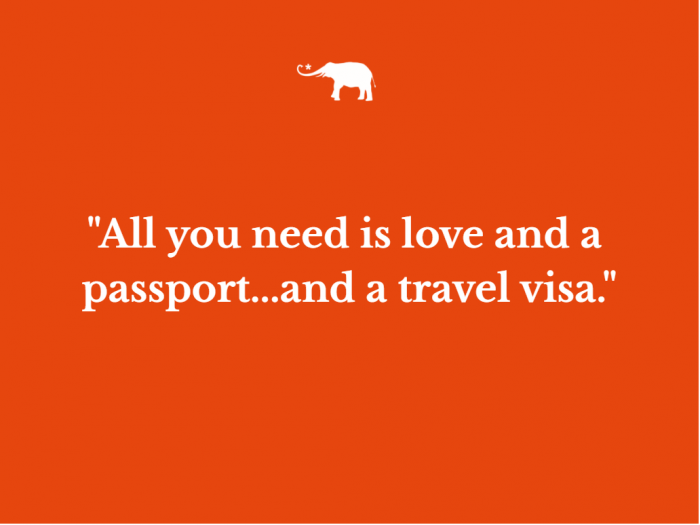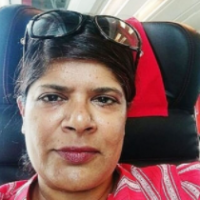I have some leave coming up. I have some spare cash lying around. I’ll just go online and see which country I can visit for a few days. Mexico? Barbados? Nassau?
I hope and pray for a day when I’ll be one of those travelers (aka Americans, Canadians, EU Passport holders) who can decide at seven in the morning to travel and their only concern is the ticket price.
For some lucky passport holders, traveling to a foreign country is that simple.
I did an anecdotal survey of all of my American and western European friends and asked them what, if anything, they knew about getting a tourist visa. Barring one (and she actually traveled to North Korea) nobody knew what an ordeal it is to apply for a tourist visa.
When someone hears that an American has traveled to 50 countries, that’s a big deal. But, as an Indian, when I say I have traveled to over 40 countries, it’s a big f*cking deal.
Let me explain why.
First of all, likely you have no idea of the torture that a non-American or a non-European traveler goes through when thinking about traveling somewhere.
This may come off as judgmental, but you haven’t really suffered for the sake of traveling if you haven’t been to a visa office or an embassy and waited hours and hours for your visa interview. Yes, that’s right, there’s an interview. And then wait in suspense before the person interviewing you decides to either accept your application or reject it.
Do I wish I had an American or an EU passport? Yes. Or even a coveted Japanese passport? Yes.
Yes, I do.
Not because I wish to become an American or a Japanese citizen. I want those passports because travelling with them is so much easier than travelling with an Indian passport (one of the less powerful passports in the world). If you want to know more, click here to find out how powerful your passport is.
But I’ve lived and learned, and now I have the experience and know the best system to almost ensure the visa application goes through.
Every single time I leave India to go somewhere, I have to get a tourist visa. And there are so many steps one has to follow to get one. While it was tough in the beginning (after two rejected visa applications), I’ve figured out how to get them and how to take most of the anger, angst, and disappointments of having your visa rejected, and turned it into a process that’s almost painless.
Honestly, I can boldly claim that unless you’re genuinely unlucky, if you follow these 12 tips you will be more likely to get your visa:
1. Complete the visa application form
The first step is obvious: find out if the country you’re applying for a visa requires you to fill out a application form. If you’re applying for a Schengen Visa, make sure you download the application form from the country to which you’re applying for the visa, the forms are mostly similar but there are differences that you should pay attention to. Rule of Thumb for Schengen: apply to the country where you’re entering first or to the country where you’ll be spending the most time in. For all other countries, go to that country’s government website and search for visa rules and forms. Some have official agencies, otherwise make sure you’re using the government’s site (most have .gov in the URL), not an agency that will charge you more (unless you want that service).
I always make an extra copy of the blank form and bring it with me to the interview. If I’ve made a mistake in the first one, I can quickly correct it and fill out the other one right there and submit. You do not want to miss your time slot or run around trying to get another form printed, wasting valuable time.
2. Details of airline and hotel booking
So, the trick here is to not actually book tickets and hotel rooms but just reserve them and get a copy of the reservation. Once you get your visa, you can confirm the booking. This requirement is mandatory for most countries these days. There are also many online services that will book your “onward flight” ticket for a few dollars.
3. Salary sheets for the past three months or more
I typically get salary sheets for the previous six months. If you don’t get a hardcopy, make sure you get details from the direct deposit in your bank account. Print a copy, highlighting the salary deposit from the previous six months.
4. Tax documents for the past three years
A lot of people I know have issues with this. Not because they don’t file taxes but because they don’t have their documents where they easily can find them. Over the past many, many years, my constant traveling has made me cognizant of the importance of this. And so, I have my tax documents from India and the country where I work with me at all times.
5. Attested bank documents
You can combine this one with point 3 if you do not have access to your salary sheets. But always make sure you get attested bank documents showing your income and bank balance for the past six months. I submit this irrespective of whether a country asks me for this or not.
For business folks, point 3 may be irrelevant to you. In that case, this one becomes crucial. Make sure to find out what the basic bank balance is that is required by the country you’re applying to, and that the balance is reflected in your account statement. Since you’re a businessperson, it would be good if you can attach copies of any fixed deposits and mutual funds you may have. Basically, the more money you show, the better chance you have of getting a visa.
6. A detailed itinerary
To get your Schengen visa, this is mandatory. For other countries, it is not always essential. But again, I’ve gotten so used to doing it for Schengen that I now do it for all countries. Make sure you do your research and come up with a schedule and print that out. You are not expected to stick to every little detail you put on the itinerary but this just shows the embassy that you are in full control of your travels and you know where you’re going and what you’ll be doing for the duration of your stay.
7. Employment letter
Again, this is a must have for some Schengen countries. This is an official letter from your place of work attesting to the fact that you’re an employee there and how valued you are. I actually write the letter myself and then have it printed out on my company’s letterhead and have it signed and stamped by the relevant administrative officials in my place of work. These days I have an employment letter template saved and I just change the dates and the country names and I’m done.
8. Copies of your ID and the address page in your passport
Make a copy of the ID page and the address page of your passport. Again, some countries ask for it, others don’t, but they almost always take it if you give it.
9. Passport-size photographs
Carry passport size photographs (some countries take their own pictures, especially when you apply for a Schengen visa and you need to get biometrics done, they will take their own pictures). But make a few copies of your photos and take them. You don’t want to run around once you get to the embassy. Make sure you get these photographs taken the way the countries require you to. Countries like the United States, England, and the Schengen countries all have their own specific rules when it comes to background color, size, if glasses are allowed, if any jewelry is allowed, the angle of the face, and so on.
10. Visa fees
Always carry more cash than the actual fees. There will always be additional service charges the embassy will levy. Also, carry a credit card. Some embassies will only take credit cards, others will only take cash. Check the currencies the embassies will accept, especially if you’re in a different country. For example the Indian Embassy in Turkey only accepts U.S. dollars in cash, not Indian rupees and not Turkish Lira. Some VFS centers in Shanghai will only take WeChat money! So, be careful with this.
11. Health insurance documents
Most countries need a copy of your health insurance for the duration of your stay in their country. Interestingly, while countries do not need actual booked airline tickets or hotel bookings to be confirmed—they do, however, demand you buy health insurance before they will even consider accepting your application. Schengen is adamant about this and, in recent years, other countries require this as well. Case in point, this was mandatory for me when I went to Turkey. The good thing about most of these health insurance policies is that the companies will change the dates if you don’t get your visa or if you get your visa for a different time frame. So you will be able to use it one way or the other. Especially with ever-changing COVID-19 restrictions, some countries require additional health insurance that states it will cover COVID-related illnesses. You can see more requirements here.
12. A cover letter to the embassy
Always write a cover letter to the embassy of the country you’re traveling to and tell them why you wish to travel to their country. This is not mandatory at all. In fact, most countries don’t ask or expect one. But I always, always, always submit one. I find that telling the embassy the exact reasons for my travels, information on my previous travels, and other pertinent details really lays it out clearly for them. It’s also professional. And every single time I’ve submitted this letter even when the embassy hasn’t asked for it, the visa guys will always, always accept it. Other items they may give back, the letter they keep.
Even as I compiled those common tips for a successful visa application process, please use that list as a general rule of thumb. In my experience, almost every country asks for these items. I typically keep all these together and submit them, what they don’t need they will return. Many embassies will also just take them and keep it whether their own list asks for it or not.
Listen, if this list overwhelms you, don’t let it.
For me, I now no longer even think about this. I have copies and templates of all of the items here. It’s just a matter of collecting them each time I travel. It’s become like clockwork for me. And I promise, it will be for you too.
Just take it one step, one point at a time and it’ll all get done.
~

 Share on bsky
Share on bsky







Read 2 comments and reply